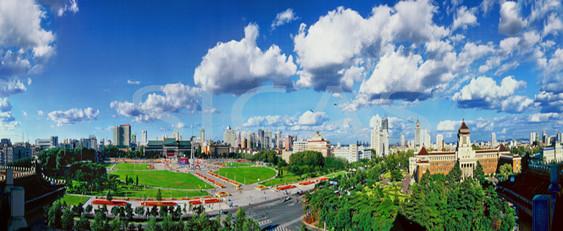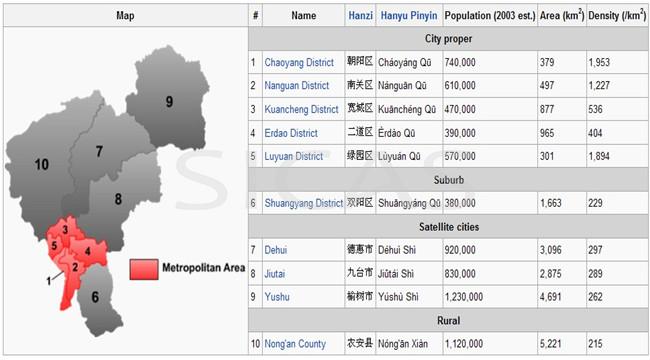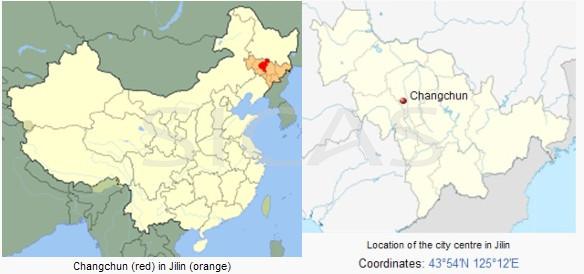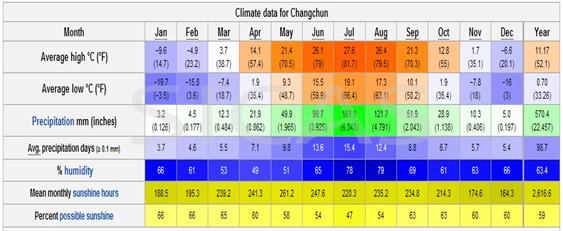
Changchun is the capital and largest city of Jilin province, located in the northeast of the People's Republic of China, in the center of the Songliao Plain. Known as China's Automobile City, Changchun is an important industrial base with a particular focus on the automotive sector. It is administered as a sub-provincial city with a population of 7,677,089 at the 2010 census under its jurisdiction, including counties and county-level cities. The name, which means "Long Spring", originated from the Jurchen language. The six urban districts of Changchun's city proper have a total population of 3,341,700 in 2010 which correspond to the built up area.
City Impression
>>Spring City of the Northern Country
>>China's Automobile City
>>the capital and largest city of Jilin province
History of Changchun
Area and Population
Location and Climate
History of Changchun
Changchun was initially established on Imperial Decree as a small Trading post and frontier village during the reign of the Jiajing Emperor. Trading activities mainly involved furs and other natural products during this period. In 1800, Emperor Jiaqing of the Qing Dynasty selected a small village on the east bank of the Yitong River and named it "Changchun Ting".
Renamed Changchun by the People's Republic of China government, it became the capital of Jilin in 1954. The Changchun Film Studio is also one of the remaining film studios of the era. Changchun Film Festival has become a unique gala for film industries since 1992. From the 1950s, Changchun was designated to become a center for China's automotive industry.
Area and Population

Changchun Administrative divisions
The sub-provincial city of Changchun has direct jurisdiction over 6 districts (区 qu), 3 county-level cities (市 shi) and 1 County (县 xian).According to the Sixth China Census, the total population of the City of Changchun reached 7.677 million in 2010. The statistics in 2011 estimated the total population to be 7.59million. The birth rate was 6.08 percent and the death rate was 5.51 percent. The urban area had a population of 3.53million people. As in most of Northeastern China the ethnic makeup of Changchun is predominantly Han nationality (96.57 percent), with several other minority nationalities.
Location and Climate

Changchun lies in the middle portion of the Northeast China Plain. Its municipality area is located at latitude 43° 05′−45° 15′ N and longitude 124° 18′−127° 02' E. The total area of Changchun municipality is 20,571 km2 (7,943 sq mi), including metro areas of 2,583 square kilometres (997 sq mi), and a city proper area of 159 km2 (61 sq mi). The city is situated at a moderate elevation, ranging from 250 to 350 metres (820 to 1,150 ft) within its administrative region. In the eastern portion of the city, there lies a small area of low mountains. The city is also situated at the crisscross point of the third east-westward “Europe-Asia Continental Bridge”[citation needed].

Changchun has a four-season, monsoon-influenced, humid continental climate (Köppen Dwa). Winters are long (lasting from November to March), cold, and windy, but dry, due to the influence of the Siberian anticyclone, with a January mean temperature of −15.1 °C (4.8 °F). Spring and fall are somewhat short transitional periods, with some precipitation, but are usually dry and windy. Summers are hot and humid, with a prevailing southeasterly wind due to the East Asian monsoon; July averages 23.1 °C (73.6 °F). Snow is usually light during the winter, and annual rainfall is heavily concentrated from June to August. A typical year will see around 2,617 hours of sunshine, and a frost-free period of 140 to 150 days. Extreme temperatures have ranged from −33 °C (−27 °F) to 35.7 °C (96 °F).
Welcome to China and Welcome to Changchun!


